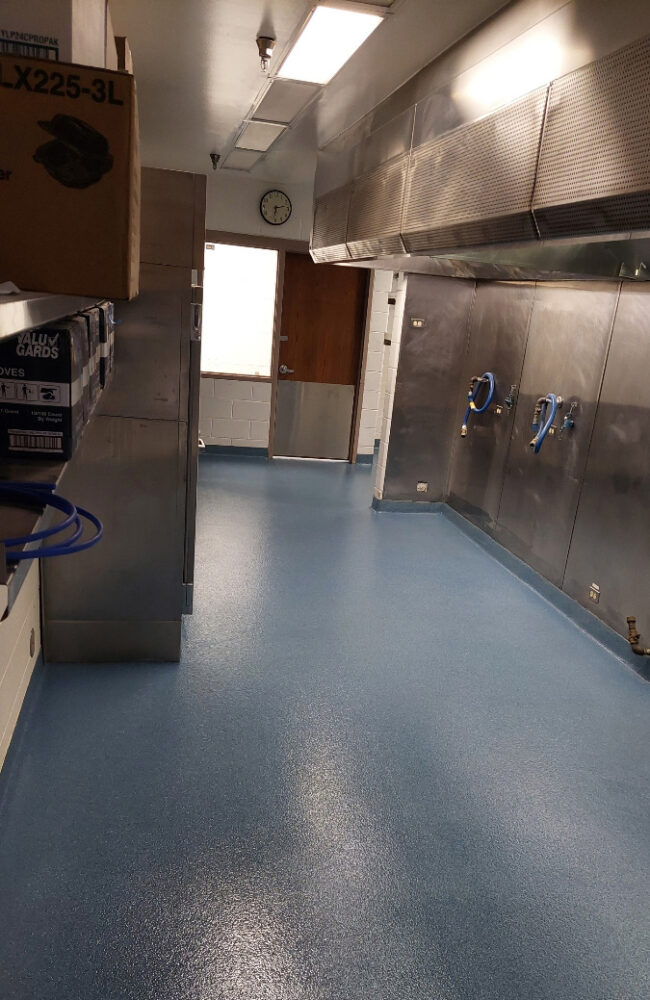How Long Does it Take For Epoxy to Dry
A common question we hear from our customers is “how long does it take for epoxy to dry?”. The answer is, like many answers in construction, “it depends”.
There are a number of factors that determine how fast a resinous floor dries as well as when it can be returned to service. This article will explain these variables and how they impact dry time.
Indoor and Outdoor Temperature
Air temperature greatly affects dry time as well as how long to stay off epoxy floors.
The warmer the temperature, the faster epoxy and other resinous materials dry.
We’ve installed urethane cement in a boiler room with 105-110 degree concrete slab temps and had to mix half batches and run to install it!
Meanwhile, we’ve also installed epoxy in a retail space in the winter that had a full panel glass window and the epoxy took nearly 24 hours to initially dry!
This leads some people to wonder if this causes potential for failures or issues with the epoxy.
Fortunately, no, epoxy floor cure time can be impeded by cold temperatures and should come out just fine in the end.
If you’re concerned about how long does it take epoxy floor to dry, you shouldn’t be.
Different Materials, Different Dry Times
Different resinous flooring materials dry at faster rates. Adding to that, typically manufacturers make different speeds of materials as well.
Epoxy
Epoxy usually has the longest working times (and longer dry times).
Polyaspartics
Polyaspartics tend to be faster and can be even faster with high temp versions (and slower with low temp).
For this reason, it can be difficult to do a large area with polyaspartics without leaving “cold joints” or areas where the previously laid material has begun to dry before the new material is allowed to work.
Urethane Cement
Urethane cement also sets up pretty quickly and doesn’t offer a lot of working time.
Also, because it typically is applied in at 1/8” to ¼” and then is thickened with broadcast quartz sand, one really needs to move fast when installing it to avoid cold joints.

How Long to Stay Off Epoxy Floor
So, how long should you stay off an epoxy floor both during installation and after installation is complete?
Assuming normal 70 degree room temperatures and that the epoxy isn’t some kind of specialty coating with unique requirements, resinous floors can be returned to service the day after they have been installed.
Polyaspartics, certain epoxies and urethane cements can usually even be walked on within 6-8 hours of install.
As a general rule of thumb, it’s best to stay off the floor until the next day and to wait 3 or more days before driving heavy equipment or vehicles on the floor.
How Long For Epoxy Floor to Cure
There is a difference between dry times and curing times for epoxy floors and other resinous floors. Curing time refers to the amount of time needed to achieve all of the specific properties that material is to be used for. Full hardness, chemical resistance, etc.
Meanwhile dry time is more appropriate to consider in terms of returning the floor to basic service. In most instances, cure time can be 5-7 days, or even longer. Yet you can walk on and use the floor the next day.
Dry time can also refer to “recoat” time. Meaning the appropriate amount of time between coats (usually ~24 hours) has passed to enable the next coat to be applied.
Check With The Installer
The best course of action is usually to check with the installer, who can then reference the manufacturer if needed.
As a quick example, we were installing a technical ESD floor and the client read the technical literature which indicated full cure was not for 7 days. They needed to return the floor to service and were afraid they would ruin the floor by using it too early. A quick call to the manufacturer was able to resolve their concern and everything was right again in the world.
Epoxy Floor Costs are Complicated
At General Industrial Flooring, we’ve been installing resinous floors in commercial and industrial settings since 1989. We’ve seen just about everything that this industry has to throw at us, so if you have questions, we probably have answers. Give us a call or send an email. We look forward to working with you on your project.
